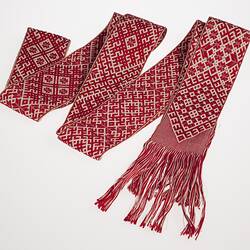Summary
Notebook documenting traditional Latvian weaving designs, 1930s-1940s.
It was kept by Anna Apinis, who attended weaving lessons in Liepaja in Latvia from 1930 to 1933. She spent hours at the nearby Ethnographic Museum recording traditional fabric designs in her notebooks. Anna continued compiling these notebooks throughout her years in Memmingen Displaced Persons camp in Germany from 1947, until she immigrated to Australia with her husband Ervins and son Erik in 1950. She painstakingly sketched and documented ancient Latvian designs from the regional costumes rescued by other Latvian refugee women in this notebook. She then wove them on her loom with threads gathered by unraveling old scraps of fabric. Anna brought her loom made from discarded timbers in the camp to Australia. Anna and her daughter Anita (born in Australia) continued to weave traditional and experimental Latvian designs throughout their lives.
Anna reflected in 1997: "Here are my notes from school, when I began to learn to weave...There was a [weaving] master (meistars), who allowed me to draw all the designs that I saw. And here they are in this notebook. And these are the designs I later wove on the loom. In the camp, it all happened in the camp, happened in Memmingen camp."
The two notebooks in the Museum's collection are unique and irreplaceable records of Latvian weaving patterns and techniques, and represent one artisan's efforts to document and preserve traditional cultural weaving practices for fear of loss due to the displacement and disruption of war. They were amongst Anna's most precious possessions, literally symbolising the preservation of her cultural traditions, and their survival is testament to Anna's determination to keep cultural alive. More than keepsakes from home, they have homeland deeply embedded in them.
Description of Content
Notebook documenting traditional Latvian weaving designs. It was kept by Anna Apinis, who attended weaving lessons in Liepaja in Latvia from 1930 to 1933. She spent hours at the nearby Ethnographic Museum recording traditional fabric designs in her notebooks. Anna continued compiling these notebooks throughout her years in Memmingen Displaced Persons camp in Germany from 1947, until she immigrated to Australia with her husband Ervins and son Erik in 1950. She painstakingly sketched and documented ancient Latvian designs from the regional costumes rescued by other Latvian refugee women in this notebook. She then wove them on her loom with threads gathered by unravelling old scraps of fabric.
Physical Description
96 page notebook with grey cardboard cover, white taped spine and red and white string assisting in binding the book together along with staples. Front cover features writing in Latvian. Graph lined pages filled with weaving designs both drawn directly onto the pages and cut out and adhered to the pages. Annotations in Latvian.
Significance
This notebook is a unique and irreplaceable record of Latvian weaving patterns and techniques, kept by a Latvian weaver and migrant to Australia. Along with the Apinis family loom, tools, textiles and other related items, it forms part of the Museum's Immigration and Artistic Practice collection. This collection represents an attempt to move beyond a solely visual appreciation of craft work towards a richer understanding of ways in which craft expresses and embraces cultural experience. This collection of art works, tools, materials, designs and oral histories deepens our understanding of the art works and artists represented in a number of ways. It highlights the importance of the process underlying the art works and renders this process more visible. In this way it contextualises the art object, not simply as an aesthetic object but a social history object created intentionally out of a specific process. The tools also stand as testament to the artist as worker, ie creation through effort and skill. They enable us to explore the relationship between the worker and their tools of trade, the symbolism and meanings which come to be attached to certain tools, and the employment of objects to create other objects. This notebook represents one artisan's efforts to document and preserve traditional cultural weaving practices for fear of loss due to the displacement and disruption of war. The notebook informed her own artistic practices transferred here to Australia.
More Information
-
Collecting Areas
-
Acquisition Information
Donation from Mrs Anita Apinis-Herman, Apr 2008
-
User
-
Inscriptions
Handwritten, front cover, black and red pen, and pencil: "2. Latvica (?) / roller shuttle / warping mill .." further handwritten inscriptions on cover.
-
Classification
-
Category
-
Discipline
-
Type of item
-
Overall Dimensions
154 mm (Width), 12 mm (Depth), 210 mm (Height)
-
References
-
Keywords
Clothing Accessories, Cultural Identity, Handcrafts, Latvian Communities, Latvian Immigration, Traditional Costumes, Weaving, Woolwork, Refugees, Displaced Persons, Displaced Persons Camps




